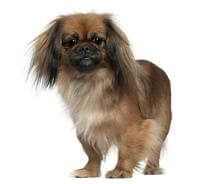Find products that match your dog’s needs

Let’s talk about one of the most regal dog breeds of all time – the Pekingese. Hailing from ancient China and bred specifically for companionship, the Pekingese dog breed still stays relevant and loved in these modern times.
These dogs are small, soft, and always ready to be pampered. Since these dogs were bred to be pampered as royal pets, they need a lot of attention and snuggles. If you are looking for a cute companion that also doubles as the perfect watchdog, you have met your match. Pekingese dogs are extremely loyal to their caregivers and always look out for them. While they may look tiny, they are surprisingly strong and brave. So, if you’re planning to bring a Pekingese home, everything you need to know is illustrated below.
Here are some Pekingese characteristics that you need to keep in mind before you bring one home:
Weight | 3 to 6 kg |
Height | 6 to 9 inches |
Lifespan | 12 to 14 years |
Coat | Double coat |
Pekingese are famous for their luscious double coat which is the longest around their neck. Although the most common coat colour for these dogs is golden, they can also be found in other shades such as:
While red and golden color coats are commonly found among the Pekingese, the rarest and the most unique colour combination ever found on them is blue and grey.
The Pekingese dog breed is often mistaken for the Shih Tzus because both breeds feature long, flowing coats. The best way to differentiate between these two breeds is to take their physical features into account. Want to make sure you are bringing a purebred Pekingese home? Look out for these characteristics:
The Pekingese are very much aware of their royal ancestry, and they sure act like it. There is a certain aloofness that you can instantly notice when you look at this breed. While they may seem aloof when you meet them, to their owners they are funny, witty, and full of personality.
The Pekingese temperament stands out because they come off as impassive, and yet are their caregivers’ private clowns. Pekingese dogs might look tiny and delicate, but they are surprisingly strong and brave dogs who are also confident and loyal to their chosen family. This sensitive breed is however described as highly affectionate and needs a lot of attention and snuggles from their caregivers.
It takes some time for a Pekingese to get accustomed to outsiders. Such traits make them amazing watchdogs for the house because they can get really erratic and snappy when they see a new face around them suddenly. If you meet a Pekingese dog and it starts barking at you, it's just protecting its family.
Does this mean that the Pekingese dog breed cannot survive with new people in a social situation? Absolutely not. There’s nothing that some good training and early socialisation cannot fix.
Pekingese dogs love to please their caregivers. However, because of their stubborn nature, it is often said that they tend to train their caregivers instead of the other way around. If you plan on bringing a Pekingese home, ensure that you start training it at an early age.
Obedience training is extremely important for the Pekingese dog breed so that their unpleasant behaviour does not become a pattern. Pekingese are said to be difficult to housetrain because of their behaviour. However, it is crucial that these dogs are trained to establish good habits at an early age. If you find it difficult to train your Pekingese, seek professional help from a certified dog trainer.
Yes, Pekingese are stubborn but once you’ve gotten through to them with kindness, patience, and a good amount of training, expect them to easily follow commands and even learn a few tricks. To make training sessions easier, just make sure to reward them with their favourite treats.
Here’s everything you need to know about taking care of your Pekingese:
The Pekingese dog breed is generally a healthy breed but there are some diseases they are susceptible to. Ailments like hemolytic anaemia, brachycephalic airway syndrome, intervertebral disc disease, heart murmurs, hernias, and elongated soft palate can affect Pekingese dogs. They are also vulnerable to several retinal issues such as dry eyes, corneal ulcers, ocular proptosis, progressive retinal atrophy, and ocular proptosis.
Pekingese dogs have thick and luscious double-coated fur that needs proper maintenance from time to time. They shed seasonally so brushing them every day is a must. Since their coat is dense and long, failing to brush it regularly can lead to knots and matting. Use a long-bristled brush so that you can get through all the hair and reach your dog’s skin.
Caregivers must remember to brush particular areas such as arms and ears, where dead skin and dirt tend to accumulate. Cleaning the insides of a Pekingese’s wrinkles and breeches is also a must. Trim your Peke’s nail once every week to make sure that it does not get hurt or store dirt and grime under its nails.
It is recommended to brush your Pekingese’s teeth every day. However, if you are not able to stay consistent, three to four times a week is also enough. When you take your Pekingese to the vet, make sure to ask them all these questions to ensure that you are headed in the right direction. Vet clinics can also help you in grooming aspects such as nail trimming and more.
To maintain a healthy lifestyle, a Pekingese should exercise for at least 30 minutes a day. Caregivers can take their Pekingese for brisk walks, short jogs, or play simple games like fetch with them in the backyard. Splitting these 30 minutes into two 15-minute sessions is highly recommended so that your Pekingese does not physically burn out. Pekingese dogs tend to overheat quickly due to their long and thick coats. This is why Pekingese parents should focus on their floof’s breathing too while working out.
High-quality dog food should always be the first choice for your pet. Sometimes pet parents can feel like feeding their Pekingese table scraps or leftovers from their meals. While it may provide you and your floof with momentary satisfaction, feeding them human food is a strict no. This is because human foods contain ingredients that are toxic to canine health. If you do not know what to feed your Pekingese dog, consult your vet.
Pekingese dogs have been known in China since A.D. 700 and became more popular with the rise of Buddhism in China. Lions and dogs that looked like lions were symbols of Buddha. The Pekingese’s lion-like mane and fur fit the bill and went on to be one of the most royal dog breeds in China. In the 1800’s, Pekingese dogs were the heart of the Chinese Imperial Court. These sleeve dogs were a true symbol of luxury and even Queen Victoria had her own darling Pekingese.
These dogs are tiny watchdogs and can sound an alarm quite bigger than their size. To avoid unnecessary barks every time it meets someone new, it must be socialised. Socialising should start early for Pekingese, after which they start getting along really well with other pets.
Pekingese are excellent family dogs. Bred to be close companions for the Chinese royalty, they have had a close bond with humans since years, making them well-suited for loving families with children.
Leaving your Pekingese dog along at home for a short time should not be a problem. However, if you leave it at home for extended hours, it may become extremely nervous and start barking. Make sure you make necessary arrangements before you leave for anywhere.
Pekingese dogs need to be groomed almost every day because of their long and luscious hair. Having said that, it does not take much time and is not very complicated.
Pekingese dogs are watchdogs. They have a very shrill voice that they use every time they register any threat. While they bark every time, they notice something out of the blue, they don’t bark a lot generally.

Find a PEDIGREE® stockist
near you!
Buy online
Click to buy from any of the retailers below

